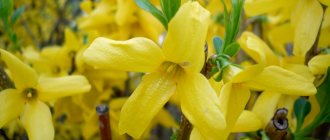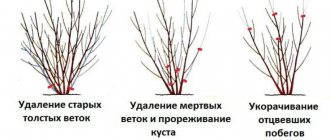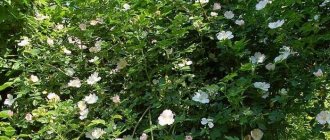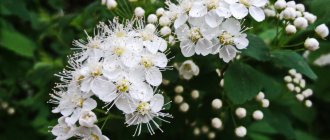If in the spring, when there is no greenery yet, and the grass is just beginning to appear, you see a bush covered with bright yellow small flowers from the base to the crown, this is forsythia, which, like the snowdrop, is considered a symbol of spring. It will bloom for 1.5-3 weeks, after which it will begin to become covered with leaves. After flowering, if gentle pruning is carried out in a timely manner, maintaining the shape of the bush, the plant looks no less decorative - in a composition with flowering and deciduous perennials it looks very harmonious and picturesque. In some varieties, the foliage changes color in the fall, and the shrub looks original until late autumn.
Features of the culture - botanical description
Forsythia, forsythia, forsythia are the names of the same plant belonging to the genus Forsythia from the Olive family. It received the scientific name “Forsythia” in honor of the botanist W. Forsyth, who brought an unfamiliar plant from an expedition to China. Under natural conditions, representatives of the genus are found in the eastern regions of Asia and southeastern Europe.
Many species (13 in total) are cultivated as ornamental beautifully flowering shrubs: F. Giraldiana, F. ovata, F. europaea, F. hanging or drooping (F. suspensa ), F. intermediate (F. intermedia), F. greenest (F. viridissima).
F. Giraldiana
F. ovata
F. europaea
It is difficult to give a general description of forsythia, since each species has its own characteristics, but there are still common characteristics. Depending on the species and place of growth, representatives of the genus can be shrubs, low trees (1-3 m in height) with a volumetric crown with a diameter of 2-2.5 m. Erect or arched shoots quickly become lignified and covered with hard grayish-brown bark.
The leaves (length 3-15 cm) begin to grow after flowering; more often they are simple, oval in shape, with a smooth edge, sometimes with small teeth, but in some species, for example, F. intermedius, the leaves are trifoliate. There are hybrids and varieties with purple, variegated leaf color - the “Spectabilis” variety turns yellow-violet with the onset of cold weather, and the “Weekend Sapphire” variety turns purple.
Spectabilis
Weekend Sapphire
It begins to bloom after the snow melts, the flowering duration is 10-20 days. The bare stems along their entire length are strewn with bright flowers of various shades of yellow, similar in shape to a bell. It is pollinated by insects, after which a fruit-box with winged seeds is formed.
With proper care, forsythia grows in one place for up to 50 years. Low (up to 100 cm) varieties, for example, “Tetragold”, “Spectabilis”, can be grown in office-type premises.
What does forsythia look like?
Forsythia (Forsythia), also known as forsythia, is a plant from the Olive family, named after the British botanist who discovered it for Europe, William Forsyth. The two different names arose due to the difference in pronunciation in English and Latin.
In nature, it is found mainly in China, with some species in South-Eastern Europe. The height of the bush is from 1 to 3.5–4 m, diameter is 1–2 m. The shoots are yellowish-beige, erect. Forsythia will not need support; the bush holds its shape well and does not “fall apart.” The leaves are oval, 5–15 cm long, with a serrated edge and a sharp tip. The lifespan of the plant is at least 50 years.
In spring, such a bright spot as a blooming forsythia inevitably attracts the eye.
Forsythia is valued by gardeners mainly for its unusually early flowering, which in nature occurs in March-April and lasts 20–40 days. In central Russia it shifts to April-May. The leaves are not yet blooming at this time, the bush, covered with small sunny yellow flowers (orange, reddish, greenish and white are less common), resembles a golden cloud. Because of this feature, the shrub received the nickname “Chinese sakura”. The shape of the flowers is similar to bells with 4 petals. They are collected in brushes of 3–5 pieces.
Forsythia shoots are literally strewn with flowers; they stay on the plant for at least 3 weeks
Breeding work with forsythia has been carried out for more than 200 years. During this time, shrubs of different heights, varying in crown shape, with large flowers were created. The shoots can be green or scarlet, the leaves can be yellow, violet, purple, reddish.
Forsythia is characterized by its growth rate, so it is rarely grown in containers. It will look appropriate only in the spacious halls of large buildings. On the site it is planted as a tapeworm and formed as a hedge. In the flowerbed, blue or purple bulbs blooming in spring - crocuses, hyacinths - will look good next to it. Branches with buds can be cut - they will open in a vase and last for 10-12 days.
Forsythia hedges hold their shape well after pruning
A significant drawback of the plant, which prevents its wide distribution in Russia, is frost resistance down to -10°C. Even in the middle zone, the bush needs high-quality shelter for the winter. Although sometimes even this does not save flower buds. In winter, birds can cause great harm to them by pecking them due to lack of food. The drooping, dark green forsythia, Giralda, tolerates frost the worst.
Single planting of forsythia is a simple but very effective solution.
Video: general description of forsythia and the nuances of caring for it
Growing conditions
Based on the conditions in the natural habitat, for planting forsythia you need to choose sunny or slightly shaded areas, protected from draft winds. A place near a fence, a building, in the openwork shade of a tree, where there is sun most of the day, will be the most comfortable. A lack of light will affect the abundance and duration of flowering and the color of the foliage.
When choosing a site, you need to take into account that the plant will grow in one place for more than one year, so it is necessary to plan the planting so that the neighbors do not interfere with each other and the beautiful bush is clearly visible. If the diameter of the crown of an adult plant reaches 2 meters or more, then between the holes you need to maintain a distance of 1.5 to 2 m. In group plantings, the gap between the bushes can be left smaller.
Shrub pruning
After three years, it may even stop producing flowers. Correct and radical pruning guarantees an abundance of flowers for many years. As a rule, we prune the bush annually after it has fully bloomed. We boldly and consistently cut from a few cm to several tens of centimeters of branches until we get the desired shape.
In the next calendar year, flowers will grow on new cut branches, so the larger the cut, the more room to grow. On perennial plants, you can even prune off entire old branches.
Keep in mind that annual pruning is by no means mandatory. If you are happy with your forsythia bushes, you can go a few years between prunings. Start by trimming 1/4 to 1/3 of the oldest branches, cutting them straight to the ground. This will encourage new growth and a more compact shape.
Besides pruning, you can also selectively cut back new branches to improve the overall shape of your forsythia plants. Young plants may only need modest pruning.
Planting rules - when and how to plant
A forsythia seedling is planted in open ground after the soil has thawed or in September so that the roots can settle in the new location before frost. If the root system is closed, then transshipment planting is acceptable in the summer. A seedling should be selected at the age of two years - a bush that is older or younger takes less root and takes longer to take root.
Choosing a seedling - what to pay attention to:
- availability of a quality certificate indicating the supplier and climatic zone of growth;
- shoots must be flexible, without damage and signs of the presence of pests;
- the root system is closed, i.e. it is in a coma of the earth, the roots do not stick out above the surface (it is acceptable if small roots are visible from the drainage holes);
- if the roots are open, then they should be developed, elastic, without signs of rot and disease.
The holes, drainage, and soil mixture are prepared in advance so that the seedling can be immediately planted in a permanent place after purchase. If possible, the soil mixture prepared in the fall (peat, sand, leaf or garden soil in the ratio 1:1:2 + 200 g of ash to neutralize peat) is frozen outside to destroy the larvae of parasites and pests.
How to plant:
- dig holes measuring 0.5x0.5x0.6 m at a distance of 1.5-2 m from each other (the interval depends on the type of planting - group, composition with other plants);
- build a drainage (h=15-20 cm) from small pebbles, crushed stone, crushed brick, pour a layer of sand on top (h=10 cm);
- fill the hole with soil so that the remaining volume corresponds to the height of the clod of earth;
- transfer the seedling, fill the voids with soil, lightly crush it, water it;
- if the root system is open, then pour a mound of earth, place a bush on top, straighten the roots, cover with soil (the root collar should be above the soil level), lightly compact, water;
- drive in a support peg;
- apply mulch from fallen healthy leaves, dry grass, chopped dry branches (it is better not to use peat - it increases acidity), tie the trunk to a support;
- When planting in autumn with the onset of cold weather, cover with material that does not retain air so that the buds do not dry out during the thaw.
Health Benefits of Forsythia Flowers
However, few people know that the flowers of the plant are not only edible, but also very beneficial for health, and in the period before harvest they can become a food hit, replacing pharmaceutical supplements. The ancient Chinese already used forsythia fruit to treat colds, flu and allergies.
Traditional medicine attributes heat resistance and poisonous properties to plants, which means, in modern language, anti-inflammatory properties. However, today we know much more about forsythia flowers and fruits.
First of all, they contain extremely high amounts of rutin, up to 1%. Rutin is a plant-derived flavonoid that plays a significant role in the process of strengthening blood vessels.
It is especially recommended for problems with varicose veins, hemorrhoids, ruptured capillaries, as well as atherosclerosis and general circulatory disorders. In its natural form it is much better absorbed than in tablet form such as rutinoscorbin.
Additionally, forsythia flowers also contain other health-promoting compounds, including quercetin, anthocyanins, saponins, and lignans. For the body, this is a powerful dose of antioxidants, which not only delay the aging process, but also strengthen the body's defenses and reduce inflammation.
Research also shows that flavonoids actually help suppress allergic reactions by reducing histamine secretion. In fact, you can even eat them raw, such as in salads or sandwiches.
For skeptics who cannot imagine chewing the petals, forsythia tea or tincture may be a reasonable alternative, and ideally a hydroalcoholic solution that demonstrates the most effective action.
To get the potion, pour 3-4 tablespoons of fresh or dried flowers with 3 tablespoons of alcohol and two cups of boiling water. Leave this solution for an hour, then after 1-2 days, strain and drink in small sips.
Care requirements
Caring for forsythia consists of the usual procedures of watering, weeding, loosening, fertilizing, and pruning. In areas with cold winters, it is necessary to provide shelter from frost.
The culture is unpretentious, but drying out or stagnation of moisture cannot be allowed, so regular but moderate watering is necessary. In hot weather, in the absence of rain, water 1-2 times a month, pouring 1.5-2 buckets of water under each bush. To prevent it from spreading, you can dig shallow grooves at a distance of 40-50 cm from the trunk and pour water into them.
After watering, the top layer of soil is loosened if lawn grass does not grow in the tree trunk circle. A mulch layer of decorative pebbles and crushed dry branches will retain moisture and not disturb the decorative effect. Weeding is carried out as necessary.
Since the plant is flowering, fertilizing is necessary to replenish nutrients. In the first year after planting, fertilizers do not need to be applied - there are enough nutrients for a young plant, then fertilizing is carried out regularly, combining them with watering:
- in the spring, after the snow melts, scatter humus, compost in the tree trunk circle, water it - organic matter activates growth and replaces mulch;
- during the budding period, feed with a complex of universal mineral fertilizer (60-120 g/1 m²);
- In early autumn, apply phosphorus-potassium fertilizer to increase resistance to cold and feed the root system.
Frost protection
Most types of forsythia can withstand light frosts (up to -10 ° C); at lower temperatures they can freeze even under cover. Species such as Giralda, European, dark green are best grown in warm climates, and the frost-resistant ovoid, intermediate, hanging species will survive wintering well in mid-latitudes.
It is not necessary to insulate adult bushes of frost-resistant varieties, but it is advisable to cover young plants so as not to expose the root system and fragile shoots to low temperatures.
Insulation options:
- Free the tree trunk circle from fallen leaves, water well and apply a layer of leaf mulch or use spruce branches, straw, or grass. Bend branches that bend easily to the ground, secure with wire, place spruce and pine branches on the bush, cover the top with spunbond, lutrasil. In winter, cover with snow.
- Build a frame of boards, slats over the bush (bend the branches), stretch burlap, lutrasil, spunbond over it - the air layer inside will protect it from frost. Instead of a frame, you can use a large cardboard box or wooden box.
In the spring, the snow must be removed from the shelter, and the covering material must be removed as soon as the snow melts, otherwise the bush will lock up and the branches touching the ground will take root.
Trimming
From a bush of the first year of life, in early spring and late autumn, shoots with damage, signs of disease, dry, frozen are removed - this is sanitary pruning. Next year, you can begin formative pruning - it is necessary to give the crown a decorative appearance, stimulate the growth of new side shoots and abundant flowering.
This should be done after flowering has ended. To do this, the young shoot is cut to half its length, and a stump about 5-6 cm high is left from the old branch. If the variety is not hanging, then the bush can be shaped into a ball or bowl.
Pruning for the purpose of rejuvenation can be carried out once every 4-5 years - all branches are shortened by 2/3 of the length. If you do it more often, the formation of flower buds will stop.
Popular questions and answers
We asked agronomist Oleg Ispolatov - he answered the most popular questions from summer residents.
How to choose forsythia seedlings?
Choose frost-resistant species and varieties - they are less hassle. An excellent option is seedlings grown in Russia - from European nurseries they do not overwinter well and suffer greatly from frost.
How to use forsythia in landscape design?
Forsythia looks great against a lawn. You can enhance the effect of its flowering by planting blue woods and botanical daffodils in the tree trunk. In complex compositions with tree species, this shrub looks better next to evergreen crops - thujas, junipers, hollies. Forsythia has beautiful foliage and rapid shoot growth, making it suitable for inclusion in hedges.
What to do with forsythia in the fall?
During this period, it is important to properly prepare the plant for winter. At the beginning of autumn, phosphorus-potassium fertilizer is applied and mulched highly. In October, water-recharging watering is carried out, the branches are bent and fixed to the ground, and covered with dry leaves in a layer of 10–15 cm or spruce branches.
What to do with forsythia in winter?
In winter, throw more light snow on the bush. At home, shoots can be driven out for flowering. Annual branches 45–50 cm long are cut before frost and stored wrapped in a plastic bag in the refrigerator. Before forcing them, they are immersed in warm water (30–35 °C) for 5–6 hours, then placed in a vase with sweetened water (25 g per 500 ml). After 9 - 11 days, the branches will be covered with golden flowers.
What to do with forsythia in spring?
As soon as the snow melts, it is necessary to remove the winter shelter from the forsythia, lift the branches, rake the mulch away from the trunk, feed it with complex mineral fertilizer and cover the tree trunk circle with a layer of humus.
Is it possible to grow forsythia in the Urals?
The most winter-hardy varieties of European forsythia are suitable for the Ural region, but these are tall plants and have their own difficulties in sheltering for the winter, so it is better to turn to frost-resistant and short varieties of ovoid forsythia. It is easier to cover them for the winter.
Is it possible to grow forsythia in Siberia?
It is believed that in Siberian conditions it is possible to grow European forsythia and oval forsythia.
However, in order to admire the flowering, it is necessary to create ideal conditions for the plants and carefully cover them for the winter, creating large hills of snow. Sources
- Forsythia // Flora of China https://www.efloras.org/florataxon.aspx?flora_id=2&taxon_id=112951
- Aksenov E., Aksenova N. Ornamental gardening for amateurs and professionals. Trees and shrubs //M.: AST-Press, 2001
- State catalog of pesticides and agrochemicals approved for use on the territory of the Russian Federation as of July 6, 2022 // Ministry of Agriculture of the Russian Federation https://mcx.gov.ru/ministry/departments/departament-rastenievodstva-mekhanizatsii-khimizatsii- i-zashchity-rasteniy/industry-information/info-gosudarstvennaya-usluga-po-gosudarstvennoy-registratsii-pestitsidov-i-agrokhimikatov/
Disease and pest control
The crop is resistant to infectious diseases and pest damage, but, which happens rarely, it is sometimes affected by a nematode, wilt or bacteriosis. When infected with a nematode, the top layer of soil must be replaced and treated with Carbation.
If the plant is affected by bacteriosis, then it cannot be saved, therefore, in order not to infect the neighbors, the bush is dug up and burned (but not on the site), and the soil is spilled with a hot solution of potassium permanganate. When wilting, when some branches become limp and then die, treatment with a fungicide will help. Prevention of the occurrence of diseases will be proper care - do not allow the soil to dry out or stagnate moisture.
5. Application in landscape design
Depending on the type, forsythia can be used as a bright, single blooming accent in a flower bed or planted as a group of plants at once. Some varieties can be used for vertical gardening, shading and at the same time decorating gazebos and verandas. Low-growing plants decorate rock gardens.
Early and abundant flowering of forsythia does not go unnoticed by bees and other beneficial insects. At a time when few plants have acquired foliage, the shrub already serves as an excellent honey plant and feeds insects hungry during the winter.
↑ Up,
From these shrubs you can build a hedge, which during the spring will delight the eye with abundant flowering, and in the fall it will decorate the garden with crimson and yellow foliage.
Varieties with long drooping shoots can be used as an attractive living arch, providing the plants with arching trellises.
Interestingly, forsythia bushes have a long lifespan and can decorate the garden for 45 - 50 years.
Forsythia branches in January - February can be used for cutting - once in warm conditions they will open their buds within 10 days.
↑ Up,
Transfer
To avoid damaging the rapidly growing roots, it is better to immediately plant forsythia in a permanent place. A young bush will tolerate replanting more easily than an adult, but, in any case, it is difficult to dig it up without damaging the roots.
If a transplant is necessary, then it must be carried out according to the following rules:
- estimate the size of the crown - the area it occupies is approximately the same as that occupied by the roots;
- cut off thick old branches, shorten the rest by 1/3 of the length (2/3 of all buds should remain on the bush);
- dig around the bush, focusing on the crown area;
- transfer the lump to a pre-dug hole, water it, and apply a layer of mulch.
You can replant in the spring, when the ground thaws and warms up, and 1.5-2 months before the autumn cold. Transplantation is possible in summer, but in the heat it is more difficult for the plant to adapt.
How to properly care for ornamental shrubs?
Forsythia is a plant with minimal care requirements, which includes pruning, watering and fertilizer. First of all, you must make sure that the plant is not subject to prolonged drought.
Especially young bushes require frequent watering due to their shallow root system. The shrub should be fed in spring and June with flowering shrub fertilizer or compost. Growing and caring for Forsythia will require moist, light and fertile soil.
It would be good for its pH to be between 6.8 and 7.7. We must water it regularly, because due to insufficient rainfall the bush dries out. It is advisable to protect the bush from the wind, and choose a place that is quite sunny, but perhaps in partial shade.
Choosing the right position and soil is a big part of success, because the bush itself is not too demanding to grow. It should also be remembered that this shrub has a shallow root system, which means that during times of drought they need watering, especially the young ones.
Reproduction methods
There are several options for propagating forsythia: seeds, cuttings and layering. The seed method is longer and more labor-intensive; flowering occurs only after 4-6 years and, moreover, hybrid varieties do not always retain their species characteristics. The other two options are used more often.
Seeds
Freshly collected seeds are used for autumn planting in open ground; for growing seedlings, seed material is stored in a cool place (+2...+5 °C) until March. At the beginning of March, the seeds are planted in a soil mixture disinfected with a manganese solution (leaf soil + humus + sand in a ratio of 2:1:1), moistened, covered with a transparent film, and the container is placed in a warm, bright place. Leaf soil can be replaced with soil for seedlings of decorative leafy crops.
The container is kept closed (film, lid) until shoots appear. Care consists of moistening the soil and ventilating the greenhouse to remove condensation. The seedlings are grown in a common container for a year, then transplanted into an individual container, and after 3-4 years - to a permanent place in open ground.
Cuttings
Preparation of cuttings is carried out in any season, but in the fall it is better to do this in October. Branches cut when forming the crown are suitable. For slicing, shoots that have not yet become lignified are selected, on which the buds are located close to each other. The length of the cutting is no more than 15 cm, the cut is made 1 cm below the bud.
All leaves are removed from the lower part, the cut (it is better to do it obliquely) is treated with a root growth stimulator and the cutting is planted in an individual container, filling it with soil for seedlings. The soil must be moistened regularly, otherwise roots will not form. If there is space, the cuttings can be planted in a greenhouse.
Cuttings prepared in the fall can be planted immediately in open ground, leaving 2-3 buds above the ground. To preserve heat, the seedling is covered with dry leaves, and in winter it is also insulated with snow. With the arrival of warmth, the snow is removed, and when the snow cover melts, the foliage is raked so that the plant does not rot.
By layering
When forsythia is propagated by layering, flowering begins already in the next season, so this method is used most often. To obtain layering, a shoot located close to the ground is bent and pinned with wire or a hook. Where the branch touches the ground, several cuts are made on the bark and covered with earth, adding humus to it for nutritional value. The following spring, the cuttings with roots are cut off and transplanted to a permanent place.
Conditions for planting forsythia in open ground
Forsythia is an amazing plant that changes its appearance every season. In spring, these are branches devoid of leaves, but densely strewn with flowers. In summer, the bush is covered with greenery, which changes color to golden or purple in autumn. When looking for a place for forsythia, you should pay attention to areas where the shrub will be clearly visible and illuminated.
Although forsythia tolerate being in the shade, in the sun the bush becomes denser and more even. The plant is undemanding to soil fertility, but develops better on soil with an alkaline reaction and good drainage. Culture:
- undemanding to care;
- has excellent frost resistance, which simplifies the wintering of forsythia in open ground;
- tolerates drought well;
- responds well to trimming and can be used for growing hedges.
There are two options for planting forsythia in the ground: in spring and autumn. In the first case, young shrubs, after acclimatization, immediately begin to grow, producing new shoots. Bushes brought into the garden in the fall only take root and begin to grow after wintering.
Helpful advice
On March 8, New Year, for a solemn family date that falls during the cold season, you can receive fresh forsythia branches strewn with flowers. Everyone will love such a bright sunny gift.
Forcing - how to do it:
- before the onset of winter frosts, cut off several annual shoots 45-50 cm long;
- wrap the branches in a bag, film and put them on the bottom shelf of the refrigerator;
- 10-12 days before the desired date, take it out and put it in water at a temperature of about 35°C for 4-5 hours;
- after that, pour warm water into the vase, dissolving sugar in it (50 g/1 l), and place the branches in it.
Reproduction
Forsythia is an easily propagated plant, both from young shoots and cuttings. If the bush is thriving and its young shoots reach close to the surface of the soil, the easiest way is to prune a little and bend towards the ground, and then partially cover it with clay.
Next year the branch will take root, and then you can easily cut it and replant it in the right place. In addition, you can also cut annual shoots from the bush about 7-10 centimeters long, clean them of leaves and immerse them in the ground.
It is worth noting that the cutting itself was done with a clean tool at an angle. Then place the seedlings in the prepared substrate and keep it moist, at a temperature of 20 to 30 degrees C, with intense exposure to sunlight.
However, be careful not to let the sun “cook” the fresh cuttings. After a few weeks the shoots should have taken root and then we can move them into position while maintaining adequate hydration.
Landing place
Lighting
- Yellow forsythia is a shade-tolerant plant, but prefers well-lit, dry areas.
- Bushes planted in bright sun bloom better and look more impressive.
- In partial shade the plant develops normally, but begins to bloom later.
- The effect of shading is noticeable even on different branches of the same plant.
Wind protection
- You should not plant forsythia in elevated places, especially in areas characterized by sharp spring gusts of wind .
- It is better to choose places protected from the cold wind near the fence, the walls of the house, next to larger trees on the south side.
Richard Elzey / Flickr.com
Jean Gazis / Flickr.com
Medicinal properties of Forsythia
In China, Forsythia is included in the 50 best medicinal plants and is used in traditional medicine. The reason for this is the composition of the plant. Its shoots contain rutin. Otherwise it is called vitamin P.
The human body needs it, but has forgotten how to produce it. Meanwhile, rutin strengthens capillaries, lowers blood pressure, and normalizes heart rhythm.
Contains forsythia and phyllirine. It belongs to the glucosides. The “family” of the latter has benefits for hair, nails, and skin. A number of essential oils enhance the effect. They are also found in Forsythia shoots.
Another component of the heroine of the article is lignans. These are polyphenols. For the body they are phytoestrogens. This is the name given to plant compounds that can replace human hormones.
Plant estrogen, when there is a lack of its own, prevents the development of cancer, mainly breast tumors. Therefore, Chinese doctors put dried forsythia in first aid kits for women.
Together, the beneficial substances of Forsythia have not only an antitumor, but also an anti-inflammatory effect. The juices of the plant help with diseases of the gallbladder, liver, and cardiovascular system.
Doctors have listed Forsythia as a broad-spectrum antibiotic, antifever and antiemetic. Prescriptions are made by traditional medicine specialists.
Forsythia shoots have a number of medicinal properties
When does forsythia bloom?
Forsythia is the earliest flowering ornamental shrub, signaling the arrival of spring. Flowers appear on the shoots even before the leaves appear. Flowering of F. intermedia (Forsythia x intermedia) - April . Thanks to selection, early flowering varieties were obtained that form buds (in March) or later ( from late April to early May ). Early flowering varieties of F. intermedia include: “Goldrausch”, “Golden Times”, “Spring Glory”, “Primula”, “Vitellina” and “Sunday”. Late-flowering varieties: “Spectabilis” and “Lynwood” finish flowering in May .
Before F. intermedia, F. drooping (Forsythia suspensa) blooms - in the second half of March . A little later, F. ovoid or oval (Forsythia ovata) - the turn of March and April . The earliest variety of F. dark green (Forsythia viridissima) “Citrus Swizzle”, under favorable weather conditions from the beginning of March .
9. Varieties and types of forsythia:
9.1.Intermediate or middle forsythia - Forsythia intermedia
The most common species in horticulture, on the basis of which the vast majority of modern varieties of cultivated plants are bred. The plants have long and thin, erect shoots, reaching a height of 3 - 4 m. In the spring it blooms immediately after the snow melts, forming single or collected in few-flowered clusters, golden buds.
↑ Up,
9.1.1. Forsythia Linwood Gold - Forsythia Linwood Gold
Compact shrubs with a spreading crown up to 2.5 meters high. The variety is distinguished by enviable frost resistance and in just one season is capable of adding from 60 to 120 cm in height.
↑ Up,
9.1.2. Forsythia intermedia Spectabilis
The variety has earned recognition in horticulture and has become widespread due to its very abundant and early flowering. The height of plants without pruning can reach 3 m.
↑ Up,
When does forsythia bloom?
The flowering period of forsythia, forsythia, occurs at a time when other plants are just waking up from their winter sleep. Although forsythia is known to bloom in the spring, it is not easy to give a specific bloom date. Certain varieties of forsythia bloom at slightly different times. Find out which species blooms earlier, which later, what affects the duration and quality of flowering, and why forsythia does not bloom.
Forsythia flower fountains: planting, feeding, pruning
After a long winter, any gardener wants to enjoy the bright colors and spring mood. Golden forsythia bushes that bloom in April can give such joy. Forsythia is a tree-like shrub of the Olive family, valued by gardeners and landscape designers around the world for its unique decorative properties.
The period of active budding begins in the first ten days of March or early April. It is during this period that lush, medium-sized yellow flowers bloom on the branches of the bush. There are representatives with white, pink and purple inflorescences. The buds are located so close that from a distance they resemble a bright crown. The formation and growth of foliage occurs in the second phase of the vegetative period, after the flowers wither.
Forsythia after flowering
To prevent forsythia from freezing in winter, it should be covered. To do this, the tree trunk circle needs to be sprinkled with fallen leaves, and the layer thickness should be 10 centimeters. The branches are bent to the soil and fixed in this position, then the bush is covered with spruce branches. At the very beginning of the spring period, the shelter must be removed and the branches freed, while fallen leaves should be removed from the trunk. If the bushes are still young, then they are covered entirely with spruce branches for the winter. If there is a lot of snow in winter, then forsythia can do without shelter, but no one can accurately predict the forecast for the entire winter.











